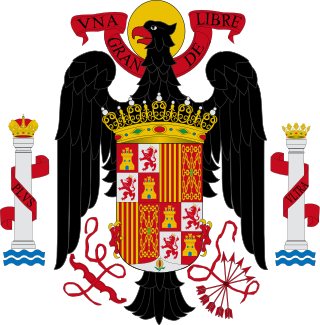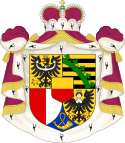
Liechtenstein is a principality governed under a constitutional monarchy. It has a form of mixed constitution in which political power is shared by the monarch and a democratically elected parliament. There is a two-party system and a form of representative democracy in which the prime minister and head of government is responsible to parliament. However the Prince of Liechtenstein is head of state and exercises considerable political powers.

Women's suffrage is the right of women to vote in elections. Beginning in the start of the 18th century, some people sought to change voting laws to allow women to vote. Liberal political parties would go on to grant women the right to vote, increasing the number of those parties' potential constituencies. National and international organizations formed to coordinate efforts towards women voting, especially the International Woman Suffrage Alliance.

Proposition 4 of 1911 was an amendment of the Constitution of California that granted women the right to vote in the state for the first time. Senate Constitutional Amendment No. 8 was sponsored by Republican State Senator Charles W. Bell from Pasadena, California. It was adopted by the California State Legislature and approved by voters in a referendum held as part of a special election on October 10, 1911.

Five referendums were held in Liechtenstein during 1992. The first was held on 15 March on whether referendums should be introduced to approve international treaties, and was approved by 71.4% of voters. The second on 28 June concerned lowering the voting age from 20 to 18, but was rejected by 56.3% of voters. Two were held on 8 November on abolishing the 8% electoral threshold and adding a clause to the constitution banning discrimination, both of which were rejected. The fifth and final referendum on 13 December was on joining the European Economic Area. It was approved by 55.8% of voters, with a voter turnout of 87%.

A referendum on the introduction of women's suffrage in national elections was held in Liechtenstein on 1 July 1984. Following the introduction of female suffrage in neighbouring Switzerland at the federal level after a referendum in 1971, Liechtenstein had been the only remaining European country to deny women the right to vote. Referendums had been held in 1968, 1971 and 1973, but on each occasion men had rejected its introduction, despite the support of newspapers and both major political parties. Nevertheless, some municipalities had since introduced female suffrage at a local level, starting with Vaduz in 1976, and women had been elected to the local councils of Vaduz and Gamprin in 1983.

A referendum on the introduction of women's suffrage was held in Liechtenstein on 28 February 1971. Voting was restricted to men, and resulted in a majority against its introduction. Voter turnout was 85.6%. Following the referendum, some women demonstrated in Vaduz and other towns, booing male pedestrians and carrying signs bearing the slogan "Men of Liechtenstein: Where's your virility".
Women in Switzerland gained the right to vote in federal elections after a referendum in February 1971. The first federal vote in which women were able to participate was the 31 October 1971 election of the Federal Assembly. However it was not until a 1990 decision by the Federal Supreme Court of Switzerland that women gained full voting rights in the final Swiss canton of Appenzell Innerrhoden.

Three referendums were held in Liechtenstein during 1973. The first was held on 11 February on introducing women's suffrage, but was rejected by 55.9% of voters. The second was held on 14 October on changing the electoral system to a candidate-based proportional system one, and was approved by 55.8% of voters. The third on 14 October was on reducing the electoral threshold from 18% to 8%, and was approved by 67.9% of voters.

The Portuguese constitutional referendum was held on 19 March 1933. A draft of the Constitution had been published one year before and the public was invited to state any objections in the press. These tended to stay in the realm of generalities and only a handful of people, less than 6,000, voted against the new constitution. With its passage, women were allowed to vote for the first time in Portugal and given a voice in the National Assembly. Secondary education was a requirement for women suffrage, while men needed only to be able to read and write.

Three referendums were held in Liechtenstein during 2011. The first on approving the registered partnership law was held between 17 and 19 June, and was approved by 68.8% of voters. The law went into effect on 1 September. The second was held on 18 September on allowing abortion within the first twelve weeks of pregnancy. Prince Alois had threatened to veto the result of the referendum should it have turned out in favour, but ultimately it was rejected by voters. The third was on building a new national hospital in Vaduz was held on 30 October, and was also rejected.
Two referendums were held in Switzerland in 1959. The first was held on 1 February on the introduction of women's suffrage at the federal level, but was rejected by 67% of voters. The second was held on 24 May on adding article 22bis to the federal constitution, which concerned civil protection. It was approved by 62% of voters.
Three referendums were held in Switzerland in 1971. The first was held on 7 February on introducing women's suffrage at the federal level, and was approved by 66% of voters. The second and third were held on 6 June on a constitutional amendment to introduce the human right to a non-hazardous environment and a federal resolution on federal finances. In the first referendum in which women were allowed to vote, both were approved by voters.

Women's suffrage was established in the United States on a full or partial basis by various towns, counties, states and territories during the latter decades of the 19th century and early part of the 20th century. As women received the right to vote in some places, they began running for public office and gaining positions as school board members, county clerks, state legislators, judges, and, in the case of Jeannette Rankin, as a member of Congress.
Melitta Marxer was a Liechtensteiner activist who spent decades organizing and fighting for women's suffrage. She is most known for speaking at the Council of Europe in 1983 to gain international support for women's right to vote.

Women's suffrage in Francoist Spain and the democratic transition was constrained by age limits, definitions around heads of household and a lack of elections. Women got the right to vote in Spain in 1933 as a result of legal changes made during the Second Spanish Republic. Women lost most of their rights after Franco came to power in 1939 at the end of the Spanish Civil War, with the major exception that women did not universally lose their right to vote. Repression of the women's vote occurred nevertheless as the dictatorship held no national democratic elections between 1939 and 1977.

A three-part referendum was held in Liechtenstein on 30 August 2020. Voters were asked whether they approve of an initiative proposing changes to the constitution to promote the equal representation of women in political bodies, a parliament law allowing dual citizenship for naturalised citizens, and a decision by the government to fund a railway line expansion. All three proposals were rejected.

Women's suffrage in Ohio was an ongoing fight with some small victories along the way. Women's rights issues in Ohio were put into the public eye in the early 1850s. Women inspired by the Declaration of Rights and Sentiments at the 1848 Seneca Falls Convention created newspapers and then set up their own conventions, including the 1950 Ohio Women's Rights Convention which was the first women's right's convention outside of New York and the first that was planned and run solely by women. These early efforts towards women's suffrage affected people in other states and helped energize the women's suffrage movement in Ohio. Women's rights groups formed throughout the state, with the Ohio Women's Rights Association (OWRA) founded in 1853. Other local women's suffrage groups are formed in the late 1860s. In 1894, women won the right to vote in school board elections in Ohio. The National American Woman Suffrage Association (NAWSA) was headquartered for a time in Warren, Ohio. Two efforts to vote on a constitutional amendment, one in 1912 and the other 1914 were unsuccessful, but drew national attention to women's suffrage. In 1916, women in East Cleveland gained the right to vote in municipal elections. A year later, women in Lakewood, Ohio and Columbus were given the right to vote in municipal elections. Also in 1917, the Reynolds Bill, which would allow women to vote in the next presidential election was passed, and then quickly repealed by a voter referendum sponsored by special-interest groups. On June 16, 1919, Ohio became the fifth state to ratify the Nineteenth Amendment.
Women's suffrage in Liechtenstein was introduced on 1 July 1984, after the 1984 Liechtenstein women's suffrage referendum. This was the last nation in Europe to introduce this right.

Attempts to secure women's suffrage in Wisconsin began before the Civil War. In 1846, the first state constitutional convention delegates for Wisconsin discussed women's suffrage and the final document eventually included a number of progressive measures. This constitution was rejected and a more conservative document was eventually adopted. Wisconsin newspapers supported women's suffrage and Mathilde Franziska Anneke published the German language women's rights newspaper, Die Deutsche Frauen-Zeitung, in Milwaukee in 1852. Before the war, many women's rights petitions were circulated and there was tentative work in forming suffrage organizations. After the Civil War, the first women's suffrage conference held in Wisconsin took place in October 1867 in Janesville. That year, a women's suffrage amendment passed in the state legislature and waited to pass the second year. However, in 1868 the bill did not pass again. The Wisconsin Woman Suffrage Association (WWSA) was reformed in 1869 and by the next year, there were several chapters arranged throughout Wisconsin. In 1884, suffragists won a brief victory when the state legislature passed a law to allow women to vote in elections on school-related issues. On the first voting day for women in 1887, the state Attorney General made it more difficult for women to vote and confusion about the law led to court challenges. Eventually, it was decided that without separate ballots, women could not be allowed to vote. Women would not vote again in Wisconsin until 1902 after separate school-related ballots were created. In the 1900s, state suffragists organized and continued to petition the Wisconsin legislature on women's suffrage. By 1911, two women's suffrage groups operated in the state: WWSA and the Political Equality League (PEL). A voter referendum went to the public in 1912. Both WWSA and PEL campaigned hard for women's equal suffrage rights. Despite the work put in by the suffragists, the measure failed to pass. PEL and WWSA merged again in 1913 and women continued their education work and lobbying. By 1915, the National Woman's Party also had chapters in Wisconsin and several prominent suffragists joined their ranks. The National Woman Suffrage Association (NAWSA) was also very present in Wisconsin suffrage efforts. Carrie Chapman Catt worked hard to keep Wisconsin suffragists on the path of supporting a federal woman's suffrage amendment. When the Nineteenth Amendment went out to the states for ratification, Wisconsin an hour behind Illinois on June 10, 1919. However, Wisconsin was the first to turn in the ratification paperwork to the State Department.
Two referendums were held in Liechtenstein during 2022. The first was held on 26 June 2022, in which voters decided on an exemption for pensioners from paying the annual deductible of the national health insurance. The second was held on 18 September on COVID-19 legislation.








